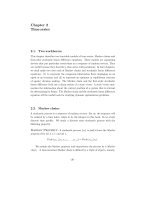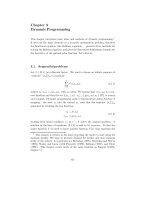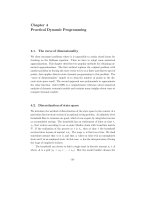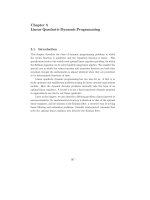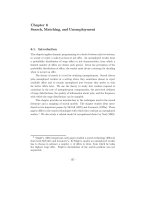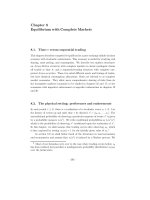Recursive macroeconomic theory
Bạn đang xem bản rút gọn của tài liệu. Xem và tải ngay bản đầy đủ của tài liệu tại đây (5.18 MB, 1,117 trang )
LARS LJUNGQVIST
THOMAS J. SARGENT
recursive
macroeconomic theory
SECOND EDITION
www.ebook3000.com
Recursive Macroeconomic Theory
Second edition
www.ebook3000.com
To our parents, Zabrina, and Carolyn
www.ebook3000.com
Recursive Macroeconomic Theory
Second edition
Lars Ljungqvist
Stockholm School of Economics
Thomas J. Sargent
New York University
and
Hoover Institution
The MIT Press
Cambridge, Massachusetts
London, England
www.ebook3000.com
c 2004 Massachusetts Institute of Technology
All rights reserved. No part of this book may be reproduced in any form by any
electronic or mechanical means (including photocopying, recording, or information
storage and retrieval) without permission in writing from the publisher.
Printed and bound in the United States of America.
Library of Congress Cataloging-in-Publication Data
Ljungqvist, Lars.
Recursive macroeconomic theory / Lars Ljungqvist, Thomas J. Sargent. – 2nd ed.
p. cm.
Includes bibliographical references and index.
ISBN 0-262-12274-X
1. Macroeconomics. 2. Recursive functions. 3. Statics and dynamics
(Social sciences)
I. Sargent, Thomas J. II. Title.
HB172.5 .L59 2004
339’.01’51135–dc22
2004054688
10 9 8 7 6 5 4 3 2 1
www.ebook3000.com
Contents
Acknowledgements
xvii
Preface to the second edition
xviii
Part I: The imperialism of recursive methods
1. Overview
3
1.1. Warning. 1.2. A common ancestor. 1.3. The savings problem.
1.3.1. Linear quadratic permanent income theory. 1.3.2. Precautionary saving. 1.3.3. Complete markets, insurance, and the distribution of
wealth. 1.3.4. Bewley models. 1.3.5. History dependence in standard
consumption models. 1.3.6. Growth theory. 1.3.7. Limiting results from
dynamic optimal taxation. 1.3.8. Asset pricing. 1.3.9. Multiple assets.
1.4. Recursive methods. 1.4.1. Methodology: dynamic programming
issues a challenge. 1.4.2. Dynamic programming challenged. 1.4.3. Imperialistic response of dynamic programming. 1.4.4. History dependence
and “dynamic programming squared”. 1.4.5. Dynamic principal-agent
problems. 1.4.6. More applications.
–v–
www.ebook3000.com
vi
Contents
Part II: Tools
2. Time Series
29
2.1. Two workhorses. 2.2. Markov chains. 2.2.1. Stationary distributions. 2.2.2. Asymptotic stationarity. 2.2.3. Expectations. 2.2.4. Forecasting functions. 2.2.5. Invariant functions and ergodicity. 2.2.6. Simulating a Markov chain. 2.2.7. The likelihood function. 2.3. Continuousstate Markov chain. 2.4. Stochastic linear difference equations. 2.4.1.
First and second moments. 2.4.2. Impulse response function. 2.4.3. Prediction and discounting. 2.4.4. Geometric sums of quadratic forms. 2.5.
Population regression. 2.5.1. The spectrum. 2.5.2. Examples. 2.6. Example: the LQ permanent income model. 2.6.1. Invariant subspace
approach. 2.7. The term structure of interest rates. 2.7.1. A stochastic discount factor. 2.7.2. The log normal bond pricing model. 2.7.3.
Slope of yield curve depends on serial correlation of log mt+1 . 2.7.4.
Backus and Zin’s stochastic discount factor. 2.7.5. Reverse engineering
a stochastic discount factor. 2.8. Estimation. 2.9. Concluding remarks.
A. A linear difference equation. 2.11. Exercises.
3. Dynamic Programming
85
3.1. Sequential problems. 3.1.1. Three computational methods. 3.1.2.
Cobb-Douglas transition, logarithmic preferences. 3.1.3. Euler equations. 3.1.4. A sample Euler equation. 3.2. Stochastic control problems.
3.3. Concluding remarks. 3.4. Exercise.
4. Practical Dynamic Programming
4.1. The curse of dimensionality. 4.2. Discretization of state space. 4.3.
Discrete-state dynamic programming. 4.4. Application of Howard improvement algorithm. 4.5. Numerical implementation. 4.5.1. Modified
policy iteration. 4.6. Sample Bellman equations. 4.6.1. Example 1: calculating expected utility. 4.6.2. Example 2: risk-sensitive preferences.
4.6.3. Example 3: costs of business cycles. 4.7. Polynomial approximations. 4.7.1. Recommended computational strategy. 4.7.2. Chebyshev polynomials. 4.7.3. Algorithm: summary. 4.7.4. Shape-preserving
splines. 4.8. Concluding remarks.
www.ebook3000.com
95
Contents
5. Linear Quadratic Dynamic Programming
vii
109
5.1. Introduction. 5.2. The optimal linear regulator problem. 5.2.1.
Value function iteration. 5.2.2. Discounted linear regulator problem.
5.2.3. Policy improvement algorithm. 5.3. The stochastic optimal linear regulator problem. 5.3.1. Discussion of certainty equivalence. 5.4.
Shadow prices in the linear regulator. 5.4.1. Stability. 5.5. A Lagrangian
formulation. 5.6. The Kalman filter. 5.6.1. Muth’s example. 5.6.2. Jovanovic’s example. 5.7. Concluding remarks. A. Matrix formulas. B.
Linear quadratic approximations. 5.B.1. An example: the stochastic
growth model. 5.B.2. Kydland and Prescott’s method. 5.B.3. Determination of z¯ . 5.B.4. Log linear approximation. 5.B.5. Trend removal.
5.10. Exercises.
6. Search, Matching, and Unemployment
139
6.1. Introduction. 6.2. Preliminaries. 6.2.1. Nonnegative random variables. 6.2.2. Mean-preserving spreads. 6.3. McCall’s model of intertemporal job search. 6.3.1. Effects of mean preserving spreads. 6.3.2. Allowing quits . 6.3.3. Waiting times. 6.3.4. Firing . 6.4. A lake model. 6.5.
A model of career choice. 6.6. A simple version of Jovanovic’s matching
model. 6.6.1. Recursive formulation and solution. 6.6.2. Endogenous
statistics. 6.7. A longer horizon version of Jovanovic’s model. 6.7.1.
The Bellman equations. 6.8. Concluding remarks. A. More numerical
dynamic programming. 6.A.1. Example 4: search. 6.A.2. Example 5: a
Jovanovic model. 6.10. Exercises.
Part III: Competitive equilibria and applications
7. Recursive (Partial) Equilibrium
7.1. An equilibrium concept. 7.2. Example: adjustment costs. 7.2.1. A
planning problem. 7.3. Recursive competitive equilibrium. 7.4. Markov
perfect equilibrium. 7.4.1. Computation. 7.5. Linear Markov perfect
equilibria. 7.5.1. An example. 7.6. Concluding remarks. 7.7. Exercises.
www.ebook3000.com
191
viii
Contents
8. Equilibrium with Complete Markets
208
8.1. Time 0 versus sequential trading. 8.2. The physical setting: preferences and endowments. 8.3. Alternative trading arrangements. 8.3.1.
History dependence. 8.4. Pareto problem. 8.4.1. Time invariance of
Pareto weights. 8.5. Time 0 trading: Arrow-Debreu securities. 8.5.1.
Equilibrium pricing function. 8.5.2. Optimality of equilibrium allocation. 8.5.3. Equilibrium computation. 8.5.4. Interpretation of trading
arrangement. 8.6. Examples. 8.6.1. Example 1: risk sharing. 8.6.2.
Example 2: no aggregate uncertainty. 8.6.3. Example 3: periodic endowment processes. 8.7. Primer on asset pricing. 8.7.1. Pricing redundant assets. 8.7.2. Riskless consol. 8.7.3. Riskless strips. 8.7.4.
Tail assets. 8.7.5. Pricing one-period returns. 8.8. Sequential trading: Arrow securities. 8.8.1. Arrow securities. 8.8.2. Insight: wealth
as an endogenous state variable. 8.8.3. Debt limits. 8.8.4. Sequential
trading. 8.8.5. Equivalence of allocations. 8.9. Recursive competitive
equilibrium. 8.9.1. Endowments governed by a Markov process. 8.9.2.
Equilibrium outcomes inherit the Markov property. 8.9.3. Recursive
formulation of optimization and equilibrium. 8.10. j -step pricing kernel. 8.10.1. Arbitrage-free pricing. 8.11. Consumption strips and the
cost of business cycles. 8.11.1. Link to business cycle costs. 8.12. Gaussian asset-pricing model. 8.13. Recursive version of Pareto problem.
8.14. Static models of trade. 8.15. Closed economy model. 8.15.1. Two
countries under autarky. 8.15.2. Welfare measures. 8.16. Two countries under free trade. 8.16.1. Small country assumption. 8.17. A tariff.
8.17.1. Nash tariff. 8.18. Concluding remarks. 8.19. Exercises.
9. Overlapping Generations Models
9.1. Endowments and preferences. 9.2. Time 0 trading. 9.2.1. Example
equilibrium. 9.2.2. Relation to the welfare theorems. 9.2.3. Nonstationary equilibria. 9.2.4. Computing equilibria. 9.3. Sequential trading. 9.4.
Money. 9.4.1. Computing more equilibria. 9.4.2. Equivalence of equilibria. 9.5. Deficit finance. 9.5.1. Steady states and the Laffer curve. 9.6.
Equivalent setups. 9.6.1. The economy. 9.6.2. Growth. 9.7. Optimality
and the existence of monetary equilibria. 9.7.1. Balasko-Shell criterion
for optimality. 9.8. Within-generation heterogeneity. 9.8.1. Nonmonetary equilibrium. 9.8.2. Monetary equilibrium. 9.8.3. Nonstationary
equilibria. 9.8.4. The real bills doctrine. 9.9. Gift-giving equilibrium.
9.10. Concluding remarks. 9.11. Exercises.
www.ebook3000.com
264
Contents
10. Ricardian Equivalence
ix
312
10.1. Borrowing limits and Ricardian equivalence. 10.2. Infinitely lived
agent economy. 10.2.1. Solution to consumption/savings decision. 10.3.
Government. 10.3.1. Effect on household. 10.4. Linked generations
interpretation. 10.5. Concluding remarks.
11. Fiscal Policies in the Growth Model
323
11.1. Introduction. 11.2. Economy. 11.2.1. Preferences, technology,
information. 11.2.2. Components of a competitive equilibrium. 11.2.3.
Competitive equilibria with distorting taxes. 11.2.4. The household:
no-arbitrage and asset-pricing formulas. 11.2.5. User cost of capital formula. 11.2.6. Firm. 11.3. Computing equilibria. 11.3.1. Inelastic labor
supply. 11.3.2. The equilibrium steady state. 11.3.3. Computing the
equilibrium path with the shooting algorithm. 11.3.4. Other equilibrium quantities. 11.3.5. Steady-state R and s/q . 11.3.6. Lump-sum
taxes available. 11.3.7. No lump-sum taxes available. 11.4. A digression on back-solving. 11.5. Effects of taxes on equilibrium allocations
and prices. 11.6. Transition experiments. 11.7. Linear approximation.
11.7.1. Relationship between the λi ’s. 11.7.2. Once-and-for-all jumps.
11.7.3. Simplification of formulas. 11.7.4. A one-time pulse. 11.7.5.
Convergence rates and anticipation rates. 11.8. Elastic labor supply.
11.8.1. Steady-state calculations. 11.8.2. A digression on accuracy: Euler equation errors. 11.9. Growth. 11.10. Concluding remarks. A. Log
linear approximations. 11.12. Exercises.
12. Recursive Competitive Equilibria
12.1. Endogenous aggregate state variable. 12.2. The stochastic growth
model. 12.3. Lagrangian formulation of the planning problem. 12.4.
Time 0 trading: Arrow-Debreu securities. 12.4.1. Household. 12.4.2.
Firm of type I. 12.4.3. Firm of type II. 12.4.4. Equilibrium prices and
quantities. 12.4.5. Implied wealth dynamics. 12.5. Sequential trading:
Arrow securities. 12.5.1. Household. 12.5.2. Firm of type I. 12.5.3. Firm
of type II. 12.5.4. Equilibrium prices and quantities. 12.5.5. Financing
a type II firm. 12.6. Recursive formulation. 12.6.1. Technology is governed by a Markov process. 12.6.2. Aggregate state of the economy.
12.7. Recursive formulation of the planning problem. 12.8. Recursive
formulation of sequential trading. 12.8.1. A “Big K , little k ” trick.
12.8.2. Price system. 12.8.3. Household problem. 12.8.4. Firm of type
I. 12.8.5. Firm of type II. 12.9. Recursive competitive equilibrium.
www.ebook3000.com
366
x
Contents
12.9.1. Equilibrium restrictions across decision rules. 12.9.2. Using the
planning problem. 12.10. Concluding remarks.
13. Asset Pricing
392
13.1. Introduction. 13.2. Asset Euler equations. 13.3. Martingale theories of consumption and stock prices. 13.4. Equivalent martingale measure. 13.5. Equilibrium asset pricing . 13.6. Stock prices without bubbles. 13.7. Computing asset prices. 13.7.1. Example 1: logarithmic
preferences. 13.7.2. Example 2: a finite-state version. 13.7.3. Example 3: asset pricing with growth. 13.8. The term structure of interest
rates. 13.9. State-contingent prices. 13.9.1. Insurance premium. 13.9.2.
Man-made uncertainty. 13.9.3. The Modigliani-Miller theorem. 13.10.
Government debt. 13.10.1. The Ricardian proposition. 13.10.2. No
Ponzi schemes. 13.11. Interpretation of risk-aversion parameter. 13.12.
The equity premium puzzle. 13.13. Market price of risk. 13.14. HansenJagannathan bounds. 13.14.1. Inner product representation of the pricing kernel. 13.14.2. Classes of stochastic discount factors. 13.14.3. A
Hansen-Jagannathan bound. 13.14.4. The Mehra-Prescott data. 13.15.
Factor models. 13.16. Heterogeneity and incomplete markets. 13.17.
Concluding remarks. 13.18. Exercises.
14. Economic Growth
449
14.1. Introduction. 14.2. The economy. 14.2.1. Balanced growth path.
14.3. Exogenous growth. 14.4. Externality from spillovers. 14.5. All factors reproducible. 14.5.1. One-sector model. 14.5.2. Two-sector model.
14.6. Research and monopolistic competition. 14.6.1. Monopolistic
competition outcome. 14.6.2. Planner solution. 14.7. Growth in spite
of nonreproducible factors. 14.7.1. “Core” of capital goods produced
without nonreproducible inputs. 14.7.2. Research labor enjoying an externality. 14.8. Concluding comments. 14.9. Exercises.
15. Optimal Taxation with Commitment
15.1. Introduction. 15.2. A nonstochastic economy. 15.2.1. Government. 15.2.2. Households. 15.2.3. Firms. 15.3. The Ramsey problem.
15.4. Zero capital tax. 15.5. Limits to redistribution. 15.6. Primal approach to the Ramsey problem. 15.6.1. Constructing the Ramsey plan.
15.6.2. Revisiting a zero capital tax. 15.7. Taxation of initial capital.
15.8. Nonzero capital tax due to incomplete taxation. 15.9. A stochastic economy. 15.9.1. Government. 15.9.2. Households. 15.9.3. Firms.
478
Contents
xi
15.10. Indeterminacy of state-contingent debt and capital taxes. 15.11.
The Ramsey plan under uncertainty. 15.12. Ex ante capital tax varies
around zero. 15.12.1. Sketch of the proof of Proposition 2. 15.13. Examples of labor tax smoothing . 15.13.1. Example 1: gt = g for all t ≥ 0 .
15.13.2. Example 2: gt = 0 for t = T , and gT > 0 . 15.13.3. Example 3:
gt = 0 for t = T , and gT is stochastic. 15.14. Lessons for optimal debt
policy. 15.15. Taxation without state-contingent debt. 15.15.1. Future
values of {gt } become deterministic. 15.15.2. Stochastic {gt } but special preferences. 15.15.3. Example 3 revisited: gt = 0 for t = T , and
gT is stochastic. 15.16. Zero tax on human capital. 15.17. Should all
taxes be zero?. 15.18. Concluding remarks. 15.19. Exercises.
Part IV: The savings problem and Bewley models
16. Self-Insurance
545
16.1. Introduction. 16.2. The consumer’s environment. 16.3. Nonstochastic endowment. 16.3.1. An ad hoc borrowing constraint: nonnegative assets. 16.3.2. Example: periodic endowment process. 16.4.
Quadratic preferences. 16.5. Stochastic endowment process: i.i.d. case.
16.6. Stochastic endowment process: general case. 16.7. Economic
intuition. 16.8. Concluding remarks. A. Supermartingale convergence
theorem. 16.10. Exercises.
17. Incomplete Markets Models
17.1. Introduction. 17.2. A savings problem. 17.2.1. Wealth-employment
distributions. 17.2.2. Reinterpretation of the distribution λ. 17.2.3. Example 1: a pure credit model. 17.2.4. Equilibrium computation. 17.2.5.
Example 2: a model with capital. 17.2.6. Computation of equilibrium.
17.3. Unification and further analysis. 17.4. Digression: the nonstochastic savings problem. 17.5. Borrowing limits: natural and ad hoc. 17.5.1.
A candidate for a single state variable. 17.5.2. Supermartingale convergence again. 17.6. Average assets as a function of r. 17.7. Computed
examples. 17.8. Several Bewley models. 17.8.1. Optimal stationary
allocation. 17.9. A model with capital and private IOUs. 17.10. Private IOUs only. 17.10.1. Limitation of what credit can achieve. 17.10.2.
Proximity of r to ρ. 17.10.3. Inside money or free banking interpretation. 17.10.4. Bewley’s basic model of fiat money. 17.11. A model of
seigniorage. 17.12. Exchange rate indeterminacy. 17.12.1. Interest on
566
xii
Contents
currency. 17.12.2. Explicit interest. 17.12.3. The upper bound on M
p .
17.12.4. A very special case. 17.12.5. Implicit interest through deflation.
17.13. Precautionary savings. 17.14. Models with fluctuating aggregate
variables. 17.14.1. Aiyagari’s model again. 17.14.2. Krusell and Smith’s
extension. 17.15. Concluding remarks. 17.16. Exercises.
Part V: Recursive contracts
18. Dynamic Stackelberg Problems
615
18.1. History dependence. 18.2. The Stackelberg problem. 18.3. Solving the Stackelberg problem. 18.3.1. Step 1: solve an optimal linear
regulator. 18.3.2. Step 2: use the stabilizing properties of shadow
price P yt . 18.3.3. Stabilizing solution. 18.3.4. Step 3: convert implementation multipliers. 18.3.5. History-dependent representation of
decision rule. 18.3.6. Digression on determinacy of equilibrium. 18.4.
A large firm with a competitive fringe. 18.4.1. The competitive fringe.
18.4.2. The monopolist’s problem. 18.4.3. Equilibrium representation.
18.4.4. Numerical example. 18.5. Concluding remarks. A. The stabilizing µt = P yt . B. Matrix linear difference equations. C. Forecasting
formulas. 18.9. Exercises.
19. Insurance Versus Incentives
19.1. Insurance with recursive contracts. 19.2. Basic environment. 19.3.
One-sided no commitment. 19.3.1. Self-enforcing contract. 19.3.2. Recursive formulation and solution. 19.3.3. Recursive computation of contract . 19.3.4. Profits. 19.3.5. P (v) is strictly concave and continuously differentiable. 19.3.6. Many households. 19.3.7. An example.
19.4. A Lagrangian method. 19.5. Insurance with asymmetric information. 19.5.1. Efficiency implies bs−1 ≥ bs , ws−1 ≤ ws . 19.5.2. Local
upward and downward constraints are enough. 19.5.3. Concavity of
P . 19.5.4. Local downward constraints always bind. 19.5.5. Coinsurance. 19.5.6. P (v) is a martingale. 19.5.7. Comparison to model with
commitment problem. 19.5.8. Spreading continuation values. 19.5.9.
Martingale convergence and poverty. 19.5.10. Extension to general
equilibrium. 19.5.11. Comparison with self-insurance. 19.6. Insurance
with unobservable storage. 19.6.1. Feasibility. 19.6.2. Incentive compatibility. 19.6.3. Efficient allocation. 19.6.4. The case of two periods
(T = 2 ). 19.6.5. Role of the planner. 19.6.6. Decentralization in a
636
Contents
xiii
closed economy. 19.7. Concluding remarks. A. Historical development.
19.A.1. Spear and Srivastava. 19.A.2. Timing. 19.A.3. Use of lotteries.
19.9. Exercises.
20. Equilibrium without Commitment
697
20.1. Two-sided lack of commitment. 20.2. A closed system. 20.3.
Recursive formulation. 20.4. Equilibrium consumption. 20.4.1. Consumption dynamics. 20.4.2. Consumption intervals cannot contain each
other. 20.4.3. Endowments are contained in the consumption intervals.
20.4.4. All consumption intervals are nondegenerate (unless autarky is
the only sustainable allocation). 20.5. Pareto frontier and ex ante division of the gains. 20.6. Consumption distribution. 20.6.1. Asymptotic
distribution. 20.6.2. Temporary imperfect risk sharing. 20.6.3. Permanent imperfect risk sharing. 20.7. Alternative recursive formulation.
20.8. Pareto frontier revisited. 20.8.1. Values are continuous in implicit consumption. 20.8.2. Differentiability of the Pareto frontier. 20.9.
Continuation values a` la Kocherlakota. 20.9.1. Asymptotic distribution
is nondegenerate for imperfect risk sharing (except for when S = 2 ).
20.9.2. Continuation values do not always respond to binding participation constraints. 20.10. A two-state example: amnesia overwhelms
memory. 20.10.1. Pareto frontier. 20.10.2. Interpretation. 20.11. A
three-state example. 20.11.1. Perturbation of parameter values. 20.11.2.
Pareto frontier. 20.12. Empirical motivation. 20.13. Generalization
. 20.14. Decentralization. 20.15. Endogenous borrowing constraints.
20.16. Concluding remarks. 20.17. Exercises.
21. Optimal Unemployment Insurance
21.1. History-dependent unemployment insurance. 21.2. A one-spell
model. 21.2.1. The autarky problem. 21.2.2. Unemployment insurance
with full information. 21.2.3. The incentive problem. 21.2.4. Unemployment insurance with asymmetric information. 21.2.5. Computed
example. 21.2.6. Computational details. 21.2.7. Interpretations. 21.2.8.
Extension: an on-the-job tax. 21.2.9. Extension: intermittent unemployment spells. 21.3. A multiple-spell model with lifetime contracts.
21.3.1. The setup. 21.3.2. A recursive lifetime contract. 21.3.3. Compensation dynamics when unemployed. 21.3.4. Compensation dynamics
while employed. 21.3.5. Summary. 21.4. Concluding remarks. 21.5. Exercises.
751
xiv
Contents
22. Credible Government Policies
773
22.1. Introduction. 22.2. Dynamic programming squared: synopsis.
22.3. The one-period economy. 22.3.1. Competitive equilibrium. 22.3.2.
The Ramsey problem. 22.3.3. Nash equilibrium. 22.4. Examples of
economies. 22.4.1. Taxation example. 22.4.2. Black-box example with
discrete-choice sets. 22.5. Reputational mechanisms: General idea.
22.5.1. Dynamic programming squared. 22.6. The infinitely repeated
economy. 22.6.1. A strategy profile implies a history and a value. 22.6.2.
Recursive formulation. 22.7. Subgame perfect equilibrium (SPE). 22.8.
Examples of SPE. 22.8.1. Infinite repetition of one-period Nash equilibrium. 22.8.2. Supporting better outcomes with trigger strategies.
22.8.3. When reversion to Nash is not bad enough. 22.9. Values of all
SPEs. 22.9.1. The basic idea of dynamic programming squared. 22.10.
Self-enforcing SPE. 22.10.1. The quest for something worse than repetition of Nash outcome. 22.11. Recursive strategies. 22.12. Examples
of SPE with recursive strategies. 22.12.1. Infinite repetition of Nash
outcome. 22.12.2. Infinite repetition of a better-than-Nash outcome.
22.12.3. Something worse: a stick-and-carrot strategy. 22.13. The best
and the worst SPE values. 22.13.1. When v1 is outside the candidate
set. 22.14. Examples: alternative ways to achieve the worst. 22.14.1.
Attaining the worst, method 1. 22.14.2. Attaining the worst, method 2.
22.14.3. Attaining the worst, method 3. 22.14.4. Numerical example.
22.15. Interpretations. 22.16. Concluding remarks. 22.17. Exercises.
23. Two Topics in International Trade
23.1. Two dynamic contracting problems. 23.2. Lending with moral
hazard and difficult enforcement. 23.2.1. Autarky. 23.2.2. Investment
with full insurance. 23.2.3. Limited commitment and unobserved investment. 23.2.4. Optimal capital outflows under distress. 23.3. Gradualism in trade policy. 23.3.1. Closed-economy model. 23.3.2. A Ricardian
model of two countries under free trade. 23.3.3. Trade with a tariff.
23.3.4. Welfare and Nash tariff. 23.3.5. Trade concessions. 23.3.6. A
repeated tariff game. 23.3.7. Time-invariant transfers. 23.3.8. Gradualism: time-varying trade policies. 23.3.9. Baseline policies. 23.3.10.
Multiplicity of payoffs and continuation values. 23.4. Concluding remarks. A. Computations for Atkeson’s model. 23.6. Exercises.
820
Contents
xv
Part VI: Classical monetary economics and search
24. Fiscal-Monetary Theories of Inflation
857
24.1. The issues. 24.2. A shopping time monetary economy. 24.2.1.
Households. 24.2.2. Government. 24.2.3. Equilibrium. 24.2.4. “Short
run” versus “long run”. 24.2.5. Stationary equilibrium. 24.2.6. Initial
date (time 0). 24.2.7. Equilibrium determination. 24.3. Ten monetary doctrines. 24.3.1. Quantity theory of money. 24.3.2. Sustained
deficits cause inflation. 24.3.3. Fiscal prerequisites of zero inflation
policy. 24.3.4. Unpleasant monetarist arithmetic. 24.3.5. An “open
market” operation delivering neutrality. 24.3.6. The “optimum quantity” of money. 24.3.7. Legal restrictions to boost demand for currency.
24.3.8. One big open market operation. 24.3.9. A fiscal theory of the
price level. 24.3.10. Exchange rate indeterminacy . 24.3.11. Determinacy of the exchange rate retrieved . 24.4. An example of exchange rate
(in)determinacy. 24.4.1. Trading before sunspot realization. 24.4.2. Fiscal theory of the price level. 24.5. Optimal inflation tax: the Friedman
rule. 24.5.1. Economic environment. 24.5.2. Household’s optimization
problem. 24.5.3. Ramsey plan. 24.6. Time consistency of monetary
policy. 24.6.1. Model with monopolistically competitive wage setting.
24.6.2. Perfect foresight equilibrium. 24.6.3. Ramsey plan. 24.6.4. Credibility of the Friedman rule. 24.7. Concluding discussion. 24.8. Exercises.
25. Credit and Currency
25.1. Credit and currency with long-lived agents. 25.2. Preferences
and endowments. 25.3. Complete markets. 25.3.1. A Pareto problem.
25.3.2. A complete markets equilibrium. 25.3.3. Ricardian proposition.
25.3.4. Loan market interpretation. 25.4. A monetary economy. 25.5.
Townsend’s “turnpike” interpretation. 25.6. The Friedman rule. 25.6.1.
Welfare. 25.7. Inflationary finance. 25.8. Legal restrictions. 25.9. A
two-money model. 25.10. A model of commodity money. 25.10.1. Equilibrium. 25.10.2. Virtue of fiat money. 25.11. Concluding remarks.
25.12. Exercises.
904
xvi
Contents
26. Equilibrium Search and Matching
940
26.1. Introduction. 26.2. An island model. 26.2.1. A single market (island). 26.2.2. The aggregate economy. 26.3. A matching model. 26.3.1.
A steady state. 26.3.2. Welfare analysis. 26.3.3. Size of the match surplus. 26.4. Matching model with heterogeneous jobs. 26.4.1. A steady
state. 26.4.2. Welfare analysis. 26.4.3. The allocating role of wages
I: separate markets. 26.4.4. The allocating role of wages II: wage announcements. 26.5. Model of employment lotteries . 26.6. Lotteries for
households versus lotteries for firms. 26.6.1. An aggregate production
function. 26.6.2. Time-varying capacity utilization. 26.7. Employment
effects of layoff taxes. 26.7.1. A model of employment lotteries with layoff taxes. 26.7.2. An island model with layoff taxes. 26.7.3. A matching
model with layoff taxes. 26.8. Kiyotaki-Wright search model of money.
26.8.1. Monetary equilibria. 26.8.2. Welfare. 26.9. Concluding comments. 26.10. Exercises.
Part VII: Technical appendixes
A. Functional Analysis
1005
A.1. Metric spaces and operators. A.2. Discounted dynamic programming. A.2.1. Policy improvement algorithm. A.2.2. A search problem.
B. Control and Filtering
1017
B.1. Introduction. B.2. The optimal linear regulator control problem.
B.3. Converting a problem with cross products in states and controls to
one with no such cross products. B.4. An example. B.5. The Kalman
filter. B.6. Duality. B.7. Examples of Kalman filtering. B.8. Linear
projections. B.9. Hidden Markov models. B.9.1. Optimal filtering.
1. References
1044
2. Index
1072
3. Author Index
1077
4. Matlab Index
1082
Acknowledgments
We wrote this book during the 1990s and early 2000s while teaching graduate courses in macro and monetary economics. We owe a substantial debt to
the students in these classes for learning with us. We would especially like to
thank Marco Bassetto, Victor Chernozhukov, Riccardo Colacito, Mariacristina
DeNardi, William Dupor, William Fuchs, George Hall, Cristobal Huneeus, Sagiri Kitao, Hanno Lustig, Sergei Morozov, Eva Nagypal, Monika Piazzesi, Navin
Kartik, Martin Schneider, Juha Sepp¨
al¨
a, Yongseok Shin, Christopher Sleet, Stijn
Van Nieuwerburgh, Laura Veldkamp, Neng Wang, Chao Wei, Mark Wright,
Sevin Yeltekin, Bei Zhang, and Lei Zhang. Each of these people made substantial suggestions for improving this book. We expect much from members of this
group, as we did from an earlier group of students that Sargent (1987b) thanked.
We received useful criticisms from Jesus Fernandez-Villaverde, Gary Hansen,
Jonathan Heathcote, Berthold Herrendorf, Mark Huggett, Charles Jones, Narayana Kocherlakota, Dirk Krueger, Per Krusell, Francesco Lippi, Rodolfo Manuelli,
Beatrix Paal, Adina Popescu, Jonathan Thomas, and Nicola Tosini.
Rodolfo Manuelli and Pierre Olivier Weill kindly allowed us to reproduce
some of their exercises. We indicate the exercises that they donated. Some of
the exercises in chapters 6, 9, and 25 are versions of ones in Sargent (1987b).
Fran¸cois Velde provided substantial help with the TEX and Unix macros that
produced this book. Maria Bharwada helped typeset it. We thank P.M. Gordon
Associates for copyediting.
For providing good environments to work on this book, Ljungqvist thanks
the Stockholm School of Economics and Sargent thanks the Hoover Institution
and the departments of economics at the University of Chicago, Stanford University, and New York University.
– xvii –
Preface to the second edition
Recursive Methods
Much of this book is about how to use recursive methods to study macroeconomics. Recursive methods are very important in the analysis of dynamic
systems in economics and other sciences. They originated after World War II in
diverse literatures promoted by Wald (sequential analysis), Bellman (dynamic
programming), and Kalman (Kalman filtering).
Dynamics
Dynamics studies sequences of vectors of random variables indexed by time,
called time series. Time series are immense objects, with as many components
as the number of variables times the number of time periods. A dynamic economic model characterizes and interprets the mutual covariation of all of these
components in terms of the purposes and opportunities of economic agents.
Agents choose components of the time series in light of their opinions about
other components.
Recursive methods break a dynamic problem into pieces by forming a sequence of problems, each one posing a constrained choice between utility today
and utility tomorrow. The idea is to find a way to describe the position of
the system now, where it might be tomorrow, and how agents care now about
where it is tomorrow. Thus, recursive methods study dynamics indirectly by
characterizing a pair of functions: a transition function mapping the state of
the model today into the state tomorrow, and another function mapping the
state into the other endogenous variables of the model. The state is a vector
of variables that characterizes the system’s current position. Time series are
generated from these objects by iterating the transition law.
– xviii –
Preface to the second edition
xix
Recursive approach
Recursive methods constitute a powerful approach to dynamic economics due
to their described focus on a tradeoff between the current period’s utility and a
continuation value for utility in all future periods. As mentioned, the simplification arises from dealing with the evolution of state variables that capture the
consequences of today’s actions and events for all future periods, and in the case
of uncertainty, for all possible realizations in those future periods. This is not
only a powerful approach to characterizing and solving complicated problems,
but it also helps us to develop intuition, conceptualize, and think about dynamic economics. Students often find that half of the job in understanding how
a complex economic model works is done once they understand what the set of
state variables is. Thereafter, the students are soon on their way to formulating
optimization problems and transition equations. Only experience from solving
practical problems fully conveys the power of the recursive approach. This book
provides many applications.
Still another reason for learning about the recursive approach is the increased importance of numerical simulations in macroeconomics, and most computational algorithms rely on recursive methods. When such numerical simulations are called for in this book, we give some suggestions for how to proceed
but without saying too much on numerical methods. 1
Philosophy
This book mixes tools and sample applications. Our philosophy is to present the
tools with enough technical sophistication for our applications, but little more.
We aim to give readers a taste of the power of the methods and to direct them
to sources where they can learn more.
Macroeconomic dynamics has become an immense field with diverse applications. We do not pretend to survey the field, only to sample it. We intend our
sample to equip the reader to approach much of the field with confidence. Fortunately for us, there are several good recent books covering parts of the field that
we neglect, for example, Aghion and Howitt (1998), Barro and Sala-i-Martin
(1995), Blanchard and Fischer (1989), Cooley (1995), Farmer (1993), Azariadis
1 Judd (1998) and Miranda and Fackler (2002) provide good treatments of numerical
methods in economics.
www.ebook3000.com
xx
Preface to the second edition
(1993), Romer (1996), Altug and Labadie (1994), Walsh (1998), Cooper (1999),
Adda and Cooper (2003), Pissarides (1990), and Woodford (2000). Stokey, Lucas, and Prescott (1989) and Bertsekas (1976) remain standard references for
recursive methods in macroeconomics. Chapters 6 and Appendix A in this book
revise material appearing in chapter 2 of Sargent (1987b).
Changes in the second edition
This edition contains seven new chapters and substantial revisions of important
parts of about half of the original chapters. New to this edition are chapters 1,
11, 12, 18, 20, 21, and 23. The new chapters and the revisions cover exciting
new topics. They widen and deepen the message that recursive methods are
pervasive and powerful.
New chapters
Chapter 1 is an overview that discusses themes that unite many of the apparently diverse topics treated in this book. Because it ties together ideas that can
be fully appreciated only after working through the material in the subsequent
chapters, we were ambivalent about whether this chapter should be first or last.
We have chosen to put this last chapter first because it tells our destination. The
chapter emphasizes two ideas: (1) a consumption Euler equation that underlies
many results in the literatures on consumption, asset pricing, and taxation; and
(2) a set of recursive ways to represent contracts and decision rules that are
history-dependent. These two ideas come together in the several chapters on
recursive contracts that form Part V of this edition. In these chapters, contracts or government policies cope with enforcement and information problems
by tampering with continuation utilities in ways that compromise the consumption Euler equation. How the designers of these contracts choose to disrupt the
consumption Euler equation depends on detailed aspects of the environment
that prevent the consumer from reallocating consumption across time in the
way that the basic permanent income model takes for granted. These chapters
on recursive contracts convey results that can help to formulate novel theories
of consumption, investment, asset pricing, wealth dynamics, and taxation.
Preface to the second edition
xxi
Our first edition lacked a self-contained account of the simple optimal
growth model and some of its elementary uses in macroeconomics and public finance. Chapter 11 corrects that deficiency. It builds on Hall’s 1971 paper
by using the standard nonstochastic growth model to analyze the effects on equilibrium outcomes of alternative paths of flat rate taxes on consumption, income
from capital, income from labor, and investment. The chapter provides many
examples designed to familiarize the reader with the covariation of endogenous
variables that are induced by both the transient (feedback) and anticipatory
(feedforward) dynamics that are embedded in the growth model. To expose the
structure of those dynamics, this chapter also describes alternative numerical
methods for approximating equilibria of the growth model with distorting taxes
and for evaluating the accuracy of the approximations.
Chapter 12 uses a stochastic version of the optimal growth model as a vehicle for describing how to construct a recursive competitive equilibrium when
there are endogenous state variables. This chapter echoes a theme that recurs
throughout this edition even more than it did in the first edition, namely, that
discovering a convenient state variable is an art. This chapter extends an idea
of chapter 8, itself an extensively revised version of chapter 7 of the first edition, namely, that a measure of household wealth is a key state variable both
for achieving a recursive representation of an Arrow-Debreu equilibrium price
system, and also for constructing a sequential equilibrium with trading each
period in one-period Arrow securities. The reader who masters this chapter will
know how to use the concept of a recursive competitive equilibrium and how to
represent Arrow securities when there are endogenous state variables.
Chapter 18 reaps rewards from the powerful computational methods for linear quadratic dynamic programming that are discussed in chapter 5, a revision
of chapter 4 of the first edition. Our new chapter 18 shows how to formulate and
compute what are known as Stackelberg or Ramsey plans in linear economies.
Ramsey plans assume a timing protocol that allows a Ramsey planner (or government) to commit, i.e., to choose once-and-for-all a complete state contingent
plan of actions. Having the ability to commit allows the Ramsey planner to
exploit the effects of its time t actions on time t + τ actions of private agents
for all τ ≥ 0 , where each of the private agents chooses sequentially. At one time,
it was thought that problems of this type were not amenable recursive methods
because they have the Ramsey planner choosing a history-dependent strategy.
Indeed, one of the first rigorous accounts of the time inconsistency of a Ramsey
xxii
Preface to the second edition
plan focused on the failure of the Ramsey planner’s problem to be recursive in
the natural state variables (i.e., capital stocks and information variables). However, it turns out that the Ramsey planner’s problem is recursive when the state
is augmented by costate variables whose laws of motion are the Euler equations
of private agents (or followers). In linear quadratic environments, this insight
leads to computations that are minor but ingenious modifications of the classic
linear-quadratic dynamic program that we present in chapter 5.
In addition to substantial new material, chapters 19 and 20 contain comprehensive revisions and reorganizations of material that had been in chapter
15 of the first edition. Chapter 19 describes three versions of a model in which a
large number of villagers acquire imperfect insurance from a planner or money
lender. The three environments differ in whether there is an enforcement problem or some type of information problem (unobserved endowments or perhaps
both an unobserved endowments and an unobserved stock of saving). Important new material appears throughout this chapter, including an account of a
version of Cole and Kocherlakota’s (2001) model of unobserved private storage.
In this model, the consumer’s access to a private storage technology means that
his consumption Euler inequality is among the implementability constraints that
the contract design must respect. That Euler inequality severely limits the planner’s ability to manipulate continuation values as a way to manage incentives.
This chapter contains much new material that allows the reader to get inside
the money-lender villager model and to compute optimal recursive contracts by
hand in some cases.
Chapter 20 contains an account of a model that blends aspects of models
of Thomas and Worrall (1988) and Kocherlakota (1996b). Chapter 15 of our
first edition had an account of this model that followed Kocherlakota’s account
closely. In this edition, we have chosen instead to build on Thomas and Worrall’s
work because doing so allows us to avoid some technical difficulties attending
Kocherlakota’s formulation. Chapter 21 uses the theory of recursive contracts to
describe two models of optimal experience-rated unemployment compensation.
After presenting a version of Shavell and Weiss’s (1979) model that was in
chapter 15 of the first edition, it describes a version of Zhao’s (2001) model
of a “lifetime” incentive-insurance arrangement that imparts to unemployment
compensation a feature like a “replacement ratio.”
Chapter 23 contains two applications of recursive contracts to two topics in
international trade. After presenting a revised version of an account of Atkeson’s
Preface to the second edition
xxiii
(1991) model of international lending with both information and enforcement
problems, it describes a version of Bond and Park’s (2002) model of gradualism
in trade agreements.
Revisions of other chapters
We have added significant amounts of material to a number of chapters, including chapters 2, 8, 15, and 16. Chapter 2 has a better treatment of laws of large
numbers and two extended economic examples (a permanent income model of
consumption and an arbitrage-free model of the term structure) that illustrate
some of the time series techniques introduced in the chapter. Chapter 8 says
much more about how to find a recursive structure within an Arrow-Debreu
pure exchange economy than did its successor. Chapter 16 has an improved
account of the supermartingale convergence theorem and how it underlies precautionary saving results. Chapter 15 adds an extended treatment of an optimal
taxation problem in an economy in which there are incomplete markets. The
supermartingale convergence theorem plays an important role in the analysis
of this model. Finally, chapter 26 contains additional discussion of models in
which lotteries are used to smooth nonconvexities facing a household and how
such models compare with ones without lotteries.
Ideas
Beyond emphasizing recursive methods, the economics of this book revolves
around several main ideas.
1. The competitive equilibrium model of a dynamic stochastic economy: This
model contains complete markets, meaning that all commodities at different
dates that are contingent on alternative random events can be traded in
a market with a centralized clearing arrangement. In one version of the
model, all trades occur at the beginning of time. In another, trading in
one-period claims occurs sequentially. The model is a foundation for assetpricing theory, growth theory, real business cycle theory, and normative
public finance. There is no room for fiat money in the standard competitive
equilibrium model, so we shall have to alter the model to let fiat money in.
xxiv
Preface to the second edition
2. A class of incomplete markets models with heterogeneous agents: The models arbitrarily restrict the types of assets that can be traded, thereby possibly igniting a precautionary motive for agents to hold those assets. Such
models have been used to study the distribution of wealth and the evolution
of an individual or family’s wealth over time. One model in this class lets
money in.
3. Several models of fiat money: We add a shopping time specification to a
competitive equilibrium model to get a simple vehicle for explaining ten
doctrines of monetary economics. These doctrines depend on the government’s intertemporal budget constraint and the demand for fiat money,
aspects that transcend many models. We also use Samuelson’s overlapping
generations model, Bewley’s incomplete markets model, and Townsend’s
turnpike model to perform a variety of policy experiments.
4. Restrictions on government policy implied by the arithmetic of budget sets:
Most of the ten monetary doctrines reflect properties of the government’s
budget constraint. Other important doctrines do too. These doctrines,
known as Modigliani-Miller and Ricardian equivalence theorems, have a
common structure. They embody an equivalence class of government policies that produce the same allocations. We display the structure of such
theorems with an eye to finding the features whose absence causes them to
fail, letting particular policies matter.
5. Ramsey taxation problem: What is the optimal tax structure when only
distorting taxes are available? The primal approach to taxation recasts
this question as a problem in which the choice variables are allocations
rather than tax rates. Permissible allocations are those that satisfy resource
constraints and implementability constraints, where the latter are budget
constraints in which the consumer and firm first-order conditions are used
to substitute out for prices and tax rates. We study labor and capital
taxation, and examine the optimality of the inflation tax prescribed by the
Friedman rule.
6. Social insurance with private information and enforcement problems: We
use the recursive contracts approach to study a variety of problems in which
a benevolent social insurer must balance providing insurance against providing proper incentives. Applications include the provision of unemployment



